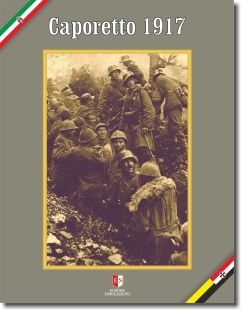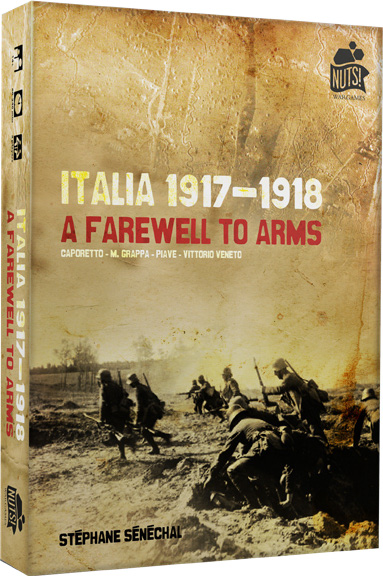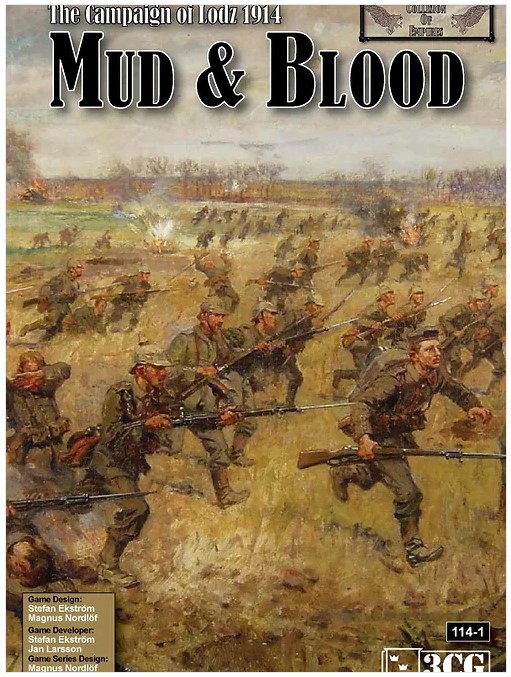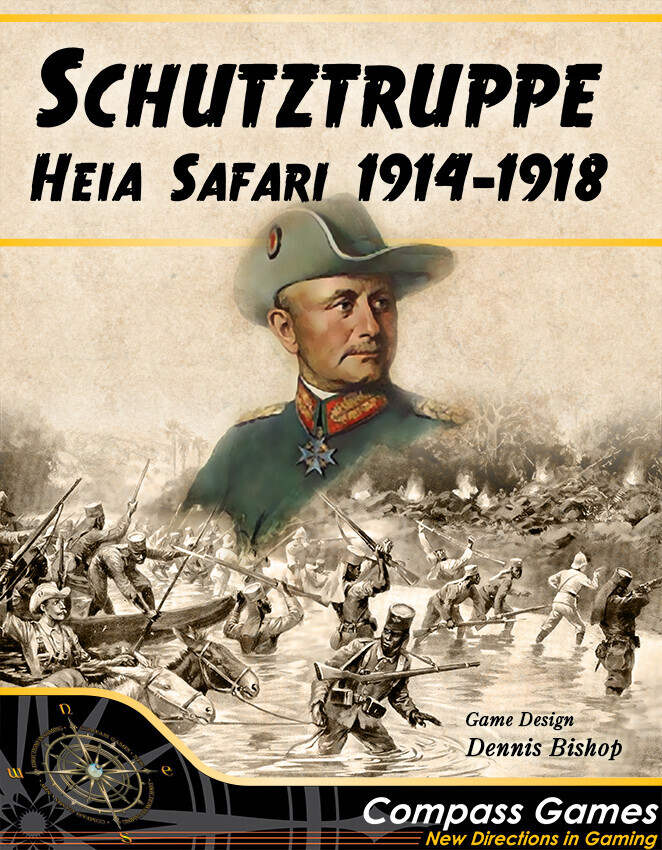Our climb through the Charles S Roberts awards for 2024 continues this week with a look at the World War One nominees and winner. As ever with these titles, many of which have small printings, use the Want List to help ensure you’re notified as soon as one becomes available. Now, let’s, uh, dive into some cardboard trenches.
An Italian Single-Battle Monster
We start with a mini monster, Caporetto 1917, the third game in The Great War series of Italian Front battles by Europa Simulazioni. A traditional hex-and-counter  setup makes its own mark, first, with a gorgeous map. At a glance you’ll see the rivers and elevation changes that make for an engaging battlefield. This isn’t a meadow where neat lines crash into one another and the winner is whomever the dice gods favor. Caporetto gives you the tools to use this terrain too, as you’ll have varied ranks, specialized tools, and elements like gas and mines. All this could mean a big rulebook to match, but Caporetto keeps itself nimble, with less than 20 pages devoted to its phases and operations.
setup makes its own mark, first, with a gorgeous map. At a glance you’ll see the rivers and elevation changes that make for an engaging battlefield. This isn’t a meadow where neat lines crash into one another and the winner is whomever the dice gods favor. Caporetto gives you the tools to use this terrain too, as you’ll have varied ranks, specialized tools, and elements like gas and mines. All this could mean a big rulebook to match, but Caporetto keeps itself nimble, with less than 20 pages devoted to its phases and operations.
Gameplay is similarly speedy, at least in the moment-to-moment. Alternating impulses keep both players involved, rather than sending one off for coffee while the other moves their whole force. The dynamism created here, as the Germans and Austro-Hungarians face off against their Italian opponents, is elevated by options for assaults and counter-assaults. In other words, you’re always on the move, always looking for an angle, and always in the action. Big games can be stodgy or slow enough to recommend themselves mainly for solitaire play. Caporetto’s blood runs hot.
You’ll find smaller scenarios thrown in the game to ease you into the rule set, though their furious, compressed battlefields make for fun afternoon sprints in their own right. Weekend warriors, though, have two campaigns to play with here. The first sets itself up as a historical simulation, where Italy is destined for defeat, but the game becomes one of how bad that defeat becomes. Can you salvage something more from the ruin than actually occurred? Those challenges are always fun, but an alternative campaign gives Italy more flexible reserves, evening the odds enough to give both players a fighting chance at victory.
Caporetto’s grand adventures play without cards or hidden information, so it’s solo-friendly, but also supports team play (splitting divisions and the like, viable given the game’s size), making it a neat group war game too. Arguing with your partner about that river crossing or how to allocate precious resources is always a good time. So, if you’re looking for a big WW1 game that gets away from the stereotypical battlefields, Caporetto’s your ticket to fast, dynamic warfare.
The Great War (Game) of Italy
Right on the heels of Caporetto is Nuts! Publishing’s Italia 1917-1918, which starts right after Caporetto and carries through the Allied and Central Powers fighting in the region. We’re zooming out here to an operational level, traditional hex-and-counter and layering on rules to cover things like artillery, exploitation attacks, and the larger unit variety. The maps, done up here in aggressive, beautiful beige, are nevertheless a neat double-sided production. For smaller scenarios, you have zoomed in scale to offer larger hexes in a great concession to ease of play. You’re not spreading a giant map on the table and ignoring 75% of it and squinting to play the last bit. More war games should take note.
and the larger unit variety. The maps, done up here in aggressive, beautiful beige, are nevertheless a neat double-sided production. For smaller scenarios, you have zoomed in scale to offer larger hexes in a great concession to ease of play. You’re not spreading a giant map on the table and ignoring 75% of it and squinting to play the last bit. More war games should take note.
Those smaller scenarios run from an hour to six or more in length, giving you plenty of opportunities to wrap your head around this system (the same used in Marne 1918: Friedensturm and Somme 1918 to form a sort of trilogy). I’d take advantage of them, as Italia does endeavor to make this a thorough simulation. When diving into the huge campaign, you’ll have much more fun with the 700 counters if you’re best pals with the rules.
Speaking of that campaign, Italia gives a good account of itself, and then asks if you’d like more. Advanced rules for the big game include reserves, unit reconstruction, and that most divisive (but flavorful addition), event cards. I always like throwing these in for the chaos factor, but if you’d prefer your randomness to come from dice alone, Italia’s happy to oblige. All told, this is a grand scope game covering a worthy part of World War One. Hex and counter veterans will enjoy it. Newbies intrigued by the theater should make a point to play the learning scenarios before diving into the campaign. Do that, and Italia’s going to be a great time.
A Snappy East Front War Game
Three Crowns Games is a neat publisher, crafting bespoke titles that do things just a little bit differently. Mud & Blood, featuring the Germans and Russians in the 1914 struggle to take the city of Lodz, is a cracking chit-pull venture that features streamlined rules, snappy movement, and tough decisions aplenty. That last  might seem obvious for a war game, but Mud & Blood puts the emphasis on your choices by keeping the rules brief (12 pages!) and the action constant. The chit pull mechanic means many of your forces simply won’t act in a given round, though your opponent won’t know which ones, making every round a white-knuckle adventure from the get-go.
might seem obvious for a war game, but Mud & Blood puts the emphasis on your choices by keeping the rules brief (12 pages!) and the action constant. The chit pull mechanic means many of your forces simply won’t act in a given round, though your opponent won’t know which ones, making every round a white-knuckle adventure from the get-go.
Once you’re off and running, keeping HQ chits in range is a delicate dance too. We’re talking movement factors of up to eight here for cavalry, a speed that puts flanking maneuvers and zippy supply cut-offs very much in play. Those HQs offer combat bonuses, but only if they’re close enough to the action, which requires putting chits in that might be better used moving or attacking with other troops. The result is a shifting battlefield that rewards decisive play, rather than stodgy lines plinking at one another.
Mud & Blood throws a number of options into the mix to increase replayability, from events to operational plan shifts (including some neat ones that trigger based on what the players do – e.g. moving forces too far from one side allows reinforcements to arrive), but your core reason to revisit this one time and again is the tension that comes from the chit pull (which makes Mud & Blood fine for solitaire play too). This is an old school production with new school rules refinement, bringing the best of both worlds together into a great game at an impulse buy price point. Furthermore, Mud & Blood’s system is used in other Three Crowns Games titles, like A Victory Complete and East Prussian Carnage, so you’re opening a door to lots of great fun.
Jungle Warfare for the Win
Part of war gaming’s charm and flexibility lies in the chance to explore lesser-known conflicts or, in this case, lesser-known parts of grant conflicts. Dipping out of the European theater to East Africa where a desperate, sneaky German force outmaneuvered and out-fought superior allied assaults over several years. Compass Games’ Schutztruppe: Heia Safari, a title earned by the call the German troops yelled out to encourage their soldiers, brings two players (or a solid solitaire experience) to the table for a moderate complexity hex-and-counter adventure.
What makes Schutztruppe stand out, and potentially gave it the winner’s crown for this category, is the asymmetry and varied play. The German side, made up of guerrillas, has incentive to scrabble around the map, salvaging reinforcements, supplies, or having to ditch their artillery to survive. The Allies have greater numbers, but are more limited in their supply restrictions and what they’re able to do. Sprawled across a map with varied terrain like jungles, lakes, and plains, both sides have to recognize their strengths while doing their best to mitigate their opponent’s. That may seem straightforward, but Schutztruppe puts these differences into sharper relief than columns on a CRT.
guerrillas, has incentive to scrabble around the map, salvaging reinforcements, supplies, or having to ditch their artillery to survive. The Allies have greater numbers, but are more limited in their supply restrictions and what they’re able to do. Sprawled across a map with varied terrain like jungles, lakes, and plains, both sides have to recognize their strengths while doing their best to mitigate their opponent’s. That may seem straightforward, but Schutztruppe puts these differences into sharper relief than columns on a CRT.
The setting gets its literal claws into you too – disease plays a significant factor, and you’ll learn to curse those die rolls that can play havoc with your forces, just as they did in real history. Choices made early in the campaign can haunt you later, either by leaving salvage for a German force to recover or, for the Germans, deciding what to abandon and what to contest. The game’s long reach comes via its single scenario, the 55-turn campaign, which could be detrimental in a more basic battle but here, with the plethora of choices and force asymmetry, offers variety aplenty. Ultimately, Schuttztruppe digs you into a conflict you’ve likely never played before and does so with slim rules and gusto. A recipe, there, for an award winner.
